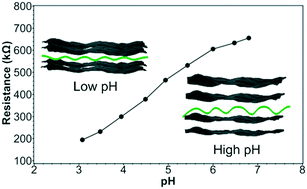当前位置:
X-MOL 学术
›
Mol. Syst. Des. Eng.
›
论文详情
Our official English website, www.x-mol.net, welcomes your feedback! (Note: you will need to create a separate account there.)
pH-Response of polycation/Ti3C2Tx MXene layer-by-layer assemblies for use as resistive sensors
Molecular Systems Design & Engineering ( IF 3.6 ) Pub Date : 2019/12/11 , DOI: 10.1039/c9me00142e Ian J. Echols 1, 2, 3 , Hyosung An 1, 2, 3 , Xiaofei Zhao 1, 2, 3 , Evan M. Prehn 2, 3, 4 , Zeyi Tan 2, 3, 4 , Miladin Radovic 2, 3, 4 , Micah J. Green 1, 2, 2, 3, 4 , Jodie L. Lutkenhaus 1, 2, 2, 3, 4
Molecular Systems Design & Engineering ( IF 3.6 ) Pub Date : 2019/12/11 , DOI: 10.1039/c9me00142e Ian J. Echols 1, 2, 3 , Hyosung An 1, 2, 3 , Xiaofei Zhao 1, 2, 3 , Evan M. Prehn 2, 3, 4 , Zeyi Tan 2, 3, 4 , Miladin Radovic 2, 3, 4 , Micah J. Green 1, 2, 2, 3, 4 , Jodie L. Lutkenhaus 1, 2, 2, 3, 4
Affiliation

|
The importance and widespread need for accurate pH monitoring necessitates the fabrication of new pH sensors with high sensitivity that can be used in a variety of environments. However, typical pH sensors have certain limitations (e.g., glass electrodes are fragile and require consistent upkeep, colorimetric pH strips are single use and inaccurate). Herein, we examine the pH-response of multilayers consisting of Ti3C2Tx nanosheets and polycations fabricated using layer-by-layer (LbL) assembly. The MXene sheets themselves are pH-responsive due to their hydroxyl surface groups, and this effect may be amplified with the choice of an appropriate polycation. Specifically, the performance of multilayers assembled with the strong electrolyte poly (diallyldimethylammonium) (PDADMA) or pH-sensitive branched polyethylenimine (BPEI) is compared. As expected, the use of a pH-sensitive constituent leads to a 464% increase in pH sensitivity (116 kΩ pH−1 unit vs. 25 kΩ pH−1 unit) as compared to PDADMA. This is due to the conformational changes that BPEI undergoes with (de)protonation as pH changes. Further comparisons with reduced graphene oxide (rGO), which is far less pH responsive, confirm the unique pH responsivity of MXene nanosheets themselves. The ability to enhance response to particular stimuli by changing the constituent polycation demonstrates promise for future use of MXenes in resistive sensors for a variety of stimuli.
中文翻译:

用作阳离子传感器的聚阳离子/ Ti3C2Tx MXene层状组件的pH响应
精确的pH监测的重要性和广泛的需求使得必须制造出可以在各种环境中使用的具有高灵敏度的新型pH传感器。但是,典型的pH传感器有一定的局限性(例如,玻璃电极易碎,需要保持一致的保养,比色pH试纸是一次性使用且不准确)。在这里,我们研究了由Ti 3 C 2 T x组成的多层膜的pH响应。纳米片和聚阳离子使用逐层组装(LbL)组装而成。MXene片材本身由于其羟基表面基团而具有pH响应性,并且可以通过选择适当的聚阳离子来增强这种效果。具体而言,比较了用强电解质聚二烯丙基二甲基铵(PDADMA)或pH敏感的支链聚乙烯亚胺(BPEI)组装的多层的性能。如预期的那样,使用pH敏感成分会使pH敏感度增加464%(116kΩpH -1单位对25kΩpH -1单位)(与PDADMA相比)。这是由于BPEI随着pH的变化(去质子化)而发生的构象变化。对还原性石墨烯氧化物(rGO)的进一步比较,后者的pH响应性要差得多,这证实了MXene纳米片本身的独特pH响应性。通过改变组成的聚阳离子来增强对特定刺激的响应的能力证明了未来将MXene用于各种刺激的电阻传感器中的希望。
更新日期:2020-02-13
中文翻译:

用作阳离子传感器的聚阳离子/ Ti3C2Tx MXene层状组件的pH响应
精确的pH监测的重要性和广泛的需求使得必须制造出可以在各种环境中使用的具有高灵敏度的新型pH传感器。但是,典型的pH传感器有一定的局限性(例如,玻璃电极易碎,需要保持一致的保养,比色pH试纸是一次性使用且不准确)。在这里,我们研究了由Ti 3 C 2 T x组成的多层膜的pH响应。纳米片和聚阳离子使用逐层组装(LbL)组装而成。MXene片材本身由于其羟基表面基团而具有pH响应性,并且可以通过选择适当的聚阳离子来增强这种效果。具体而言,比较了用强电解质聚二烯丙基二甲基铵(PDADMA)或pH敏感的支链聚乙烯亚胺(BPEI)组装的多层的性能。如预期的那样,使用pH敏感成分会使pH敏感度增加464%(116kΩpH -1单位对25kΩpH -1单位)(与PDADMA相比)。这是由于BPEI随着pH的变化(去质子化)而发生的构象变化。对还原性石墨烯氧化物(rGO)的进一步比较,后者的pH响应性要差得多,这证实了MXene纳米片本身的独特pH响应性。通过改变组成的聚阳离子来增强对特定刺激的响应的能力证明了未来将MXene用于各种刺激的电阻传感器中的希望。


























 京公网安备 11010802027423号
京公网安备 11010802027423号